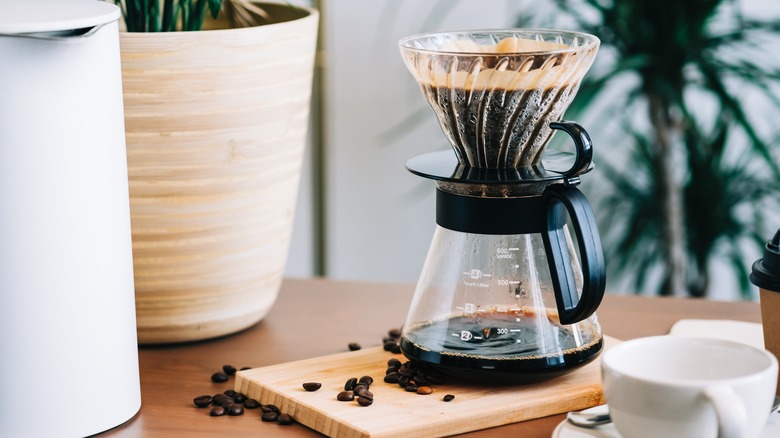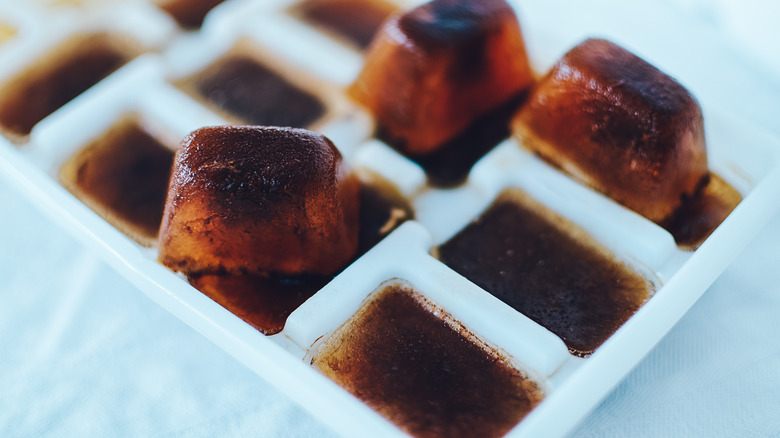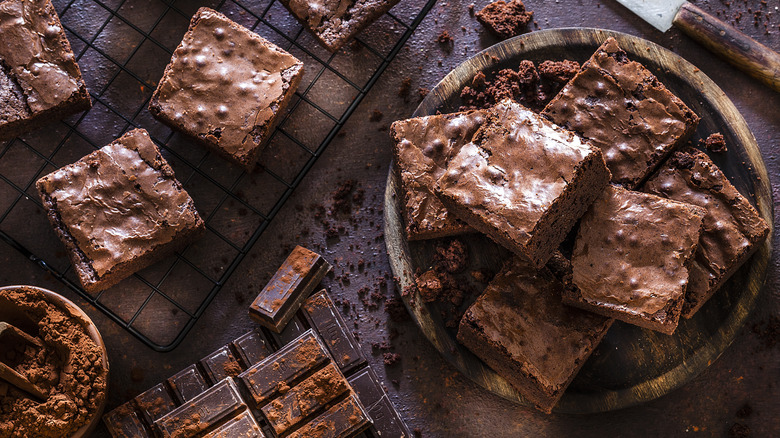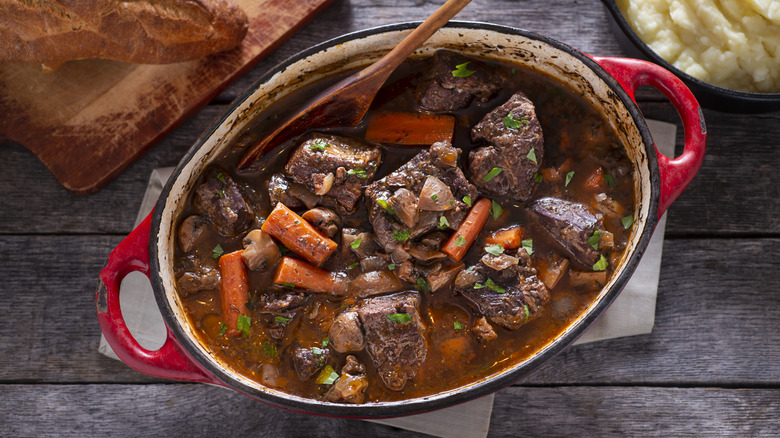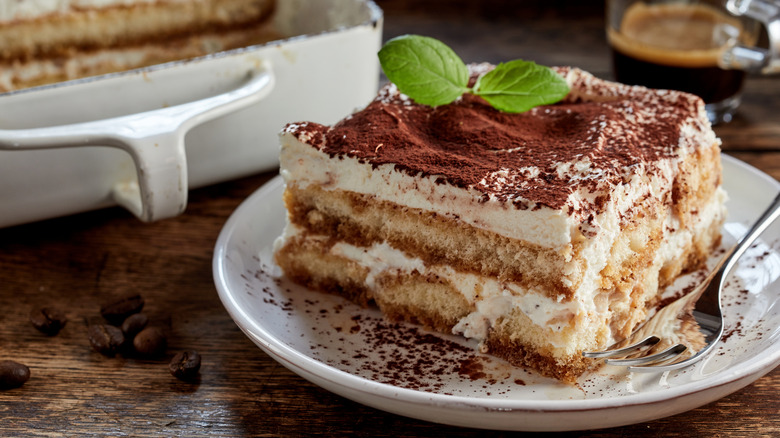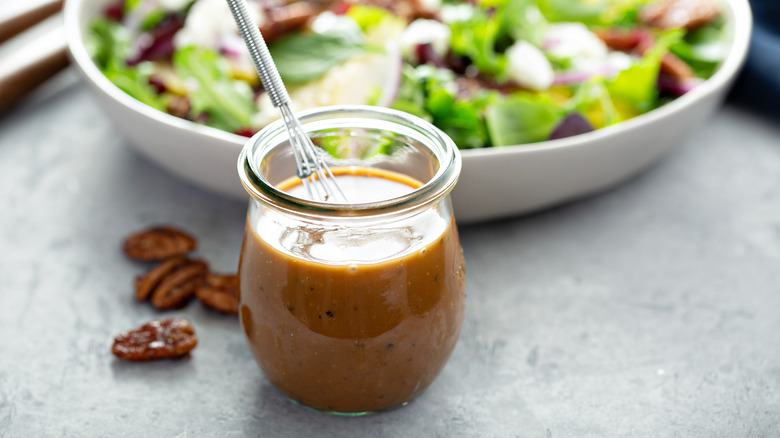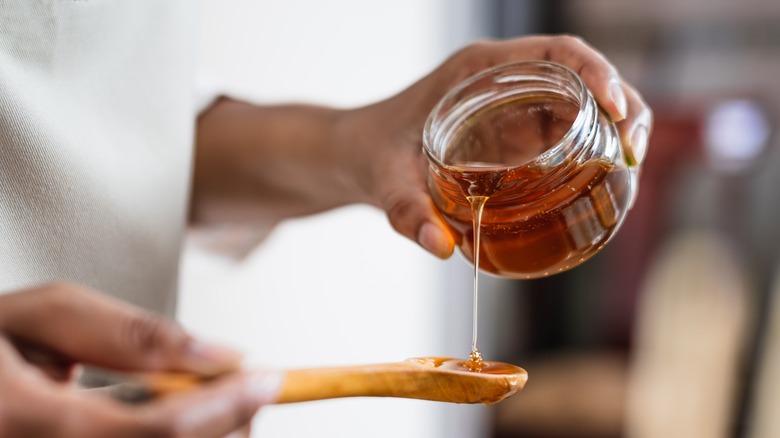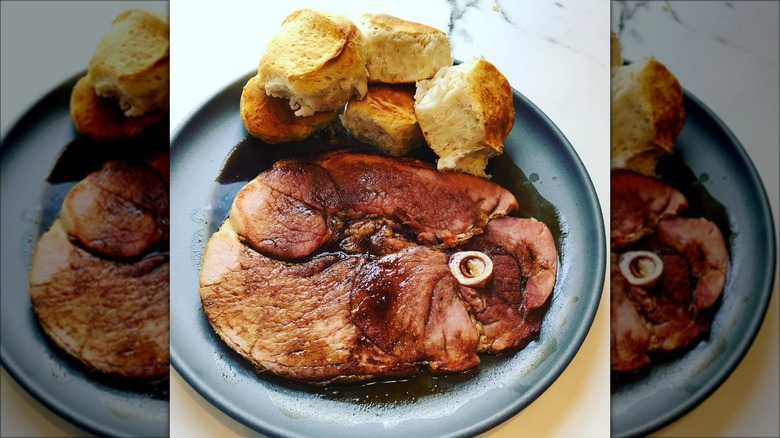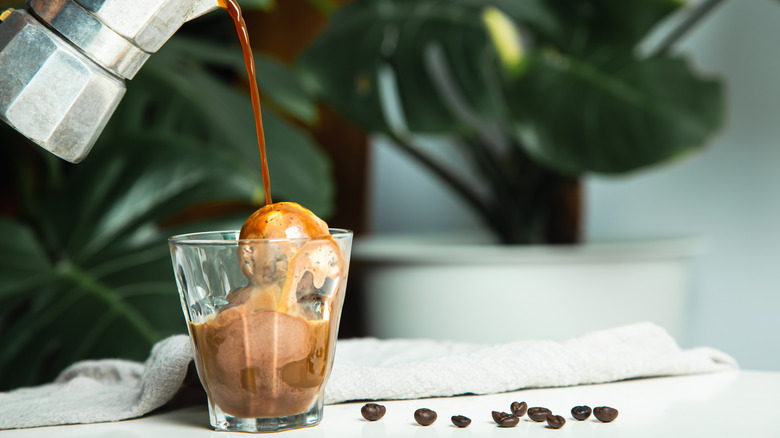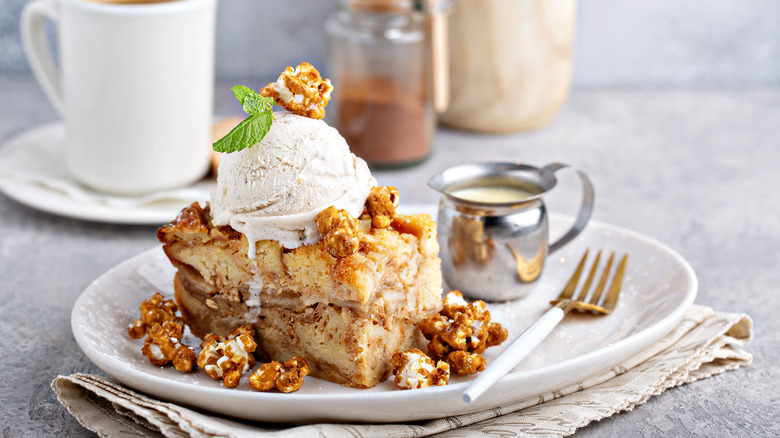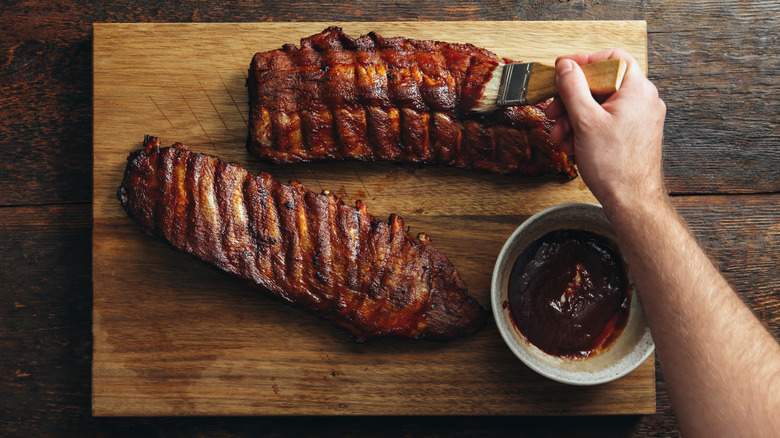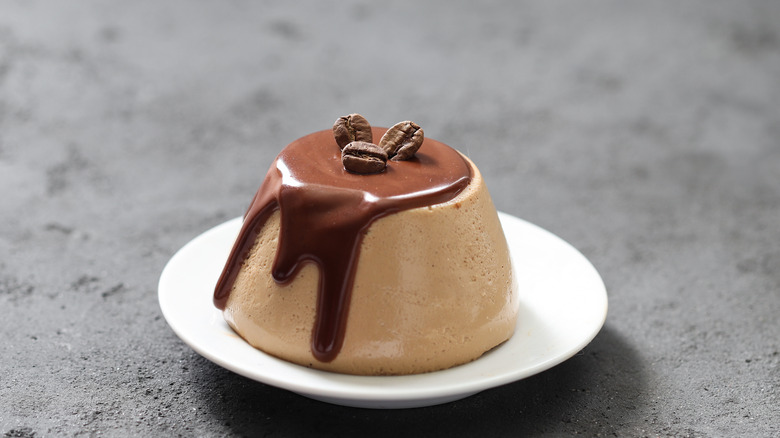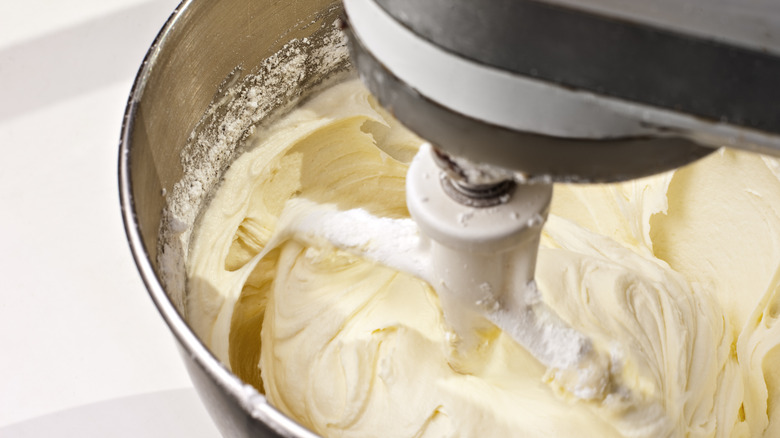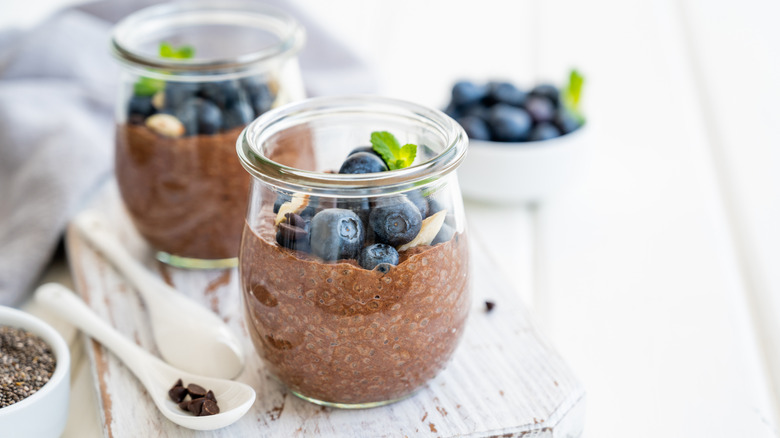What To Do With Leftover Coffee (Rather Than Throw Out Good Java)
Coffee is an integral part of daily life for a lot of people. In fact, for many of us, it's one of the first things we think about when we wake up and the first order of business we attend to in the morning. According to data collected by Drive Research, three out of every four Americans (74%) drink coffee on a daily basis, and 68% of them brew it at home. If you're in that latter category, you probably end up with leftovers on occasion. Maybe you make too much because you overestimate your morning cravings. Maybe your plans for the day change, and you end up buying an afternoon latte at a coffee shop rather than finishing what you have at home. Or maybe you simply ascribe to the philosophy that it's better to have too much than too little. Whatever the reason, we've all poured coffee down the drain at some point, knowing that we're maxed out on caffeine but wishing we didn't have to waste the all-important brew.
Luckily, there are plenty of ways to repurpose leftover coffee that don't involve swigging another mug full of caffeine. Some of them are so delicious that you might start intentionally making more coffee than you can drink just so you can turn it into one of these recipes. And while you're at it, check out our guide for repurposing leftover coffee grounds.
Make coffee ice cubes
Nothing hits the spot quite like iced coffee on a hot summer's day. Creamy, cold, and invigorating, it's a must-have beverage when the temperature spikes, but you still need to be productive. Unfortunately, ice and the heat of the summer do not mix well, and unless you gulp down your chilled latte in under five minutes, you're going to end up with tepid, watered-down coffee that is disappointing on every level.
There is, however, a solution: coffee ice cubes. Pouring your leftover brew into ice trays ensures that you have iced coffee that doesn't get watered down even as the cubes melt. Plus, you won't have to toss your excess coffee down the drain. This is by far one of the easiest ways to repurpose leftover brew. As long as you have a freezer and an empty ice tray, you are good to go. No cooking, mixing, or extra ingredients required, though you can certainly add chocolate milk if you want mocha ice cubes for your next latte.
Add it to your brownie recipe
It's hard to improve upon a classic brownie recipe. The dense chocolate, crinkly top, and chewy texture amount to the perfect dessert, but if you're willing to branch out, adding coffee does nothing to detract from the pure-chocolate original. You could even argue that it's an improvement.
Coffee and chocolate have been paired since at least the 16th century when coffee shops in Venice and Turin began mixing the ingredients into a single drink. You could even say that they were destined to be together. Both are derived from the seeds of tropical plants (contrary to common parlance, coffee beans are, in fact, seeds), and both undergo fermentation. Both have intense, somewhat bitter flavors, and you will often see chocolate listed as one of the tasting notes on a bag of coffee beans.
Even the word for the combination of these ingredients, mocha, is indicative of their closeness. In the 1700s, mocha coffee beans were the most coveted variety, named after the port of Al Mokha in modern-day Yemen where beans were traded. These beans (which we now know as arabica coffee) were said to have a chocolatey taste, likely leading to our use of the word "mocha" to mean a combination of the two ingredients. Even if you are a chocolate purist, adding coffee to your brownie recipe will not dilute the chocolate flavor; it will enhance it. Use as little as a few tablespoons or as much as half a cup.
Add it to stew
Even if you drink your coffee black with no sugar, you probably still think of it as a sweet rather than a savory beverage. However, many of the best ways to use leftover coffee involve savory dishes. That may change the way you think about your morning brew forever. Believe it or not, coffee can be the secret ingredient to a rich, meaty stew.
If you think about it, it makes sense. On its own, coffee has a powerful, bitter flavor that, like wine, lends itself to cooking. When you add it to a hearty beef stew, it doesn't make the dish taste like a nausea-inducing mashup between a shepherd's pie and a cappuccino. It makes it taste like an intensely rich, flavorful stew.
Using a darker roast of coffee when cooking savory foods is best, as it will have a deeper flavor and bring out the rich flavor of the meat. Light roasts taste more acidic, which, for rich stews, is not always the best contribution. Think of a lighter roast like a squeeze of lemon. If you think your stew would benefit from a dash of the citrus fruit, a light roast might be perfect. Otherwise, err on the side of a dark roast.
Make tiramisu
A classic tiramisu is nothing short of flawless. With layers of ladyfingers soaked in espresso and liquor, mascarpone cheese, and cocoa powder, it's one of those desserts that just can't be improved upon. It's sweet with a kick, both from the espresso and the alcohol, and it has a heavenly silky texture that still manages to be dense, decadent, and light all at once.
It is the perfect dessert for coffee lovers, especially those who have leftovers from their morning brew. Instead of pouring the excess coffee down the drain, you should consider creating this classic Italian dessert, which offers the ideal opportunity to transform the unwanted dregs in your French press to one of the most sophisticated treats you can make. The best part is that tiramisu requires more than just a few tablespoons of coffee, so you'll probably be able to get rid of most — if not all — of your leftovers. Recipes vary, but they can be expected to use somewhere between a quarter cup and two cups of coffee.
Liven up your salad dressing
Salad dressing is one of the most enjoyable ingredients to make at home because there are infinite flavor combinations you can create. If you're free-styling it rather than using a recipe, it also provides an opportunity to use up the ingredients you just can't get around to finishing, whether that's a bottle of tamari, a jar of honey, or the last teaspoon of sriracha. Salad dressing is very forgiving. If you add too much vinegar, you can balance it with a little sugar and salt. If it's too sweet, simply add more mustard or garlic. Because of this, coffee is an excellent addition that isn't nearly as perilous as it might seem.
Black coffee adds a unique depth and complexity to salad dressing. Its bitterness can be easily tempered by sugar, and its savory quality can be drawn out by vinegar or soy sauce. For a simple dressing, all you need is equal parts balsamic vinegar, coffee, and a sweetener of some kind (honey, maple syrup, and sugar are all good candidates). If you want a dressing with a little more pep, add Dijon mustard, minced garlic, and fresh herbs along with some olive oil to that simple base.
Create a multipurpose syrup
Having a jar of maple syrup or a bottle of honey around is a basic necessity for any home cook. You never know when you'll get a hankering for pancakes or oatmeal or need to dress up a humble piece of buttered toast. But there is no need to stop there. Making your own flavored syrup is easy, and, in the case of leftover coffee, it's a great way to avoid pouring one of your favorite beverages down the drain.
A simple sugar syrup is made by simmering sugar in water until it dissolves and becomes viscous. Because coffee is essentially just flavored water, it's easy to substitute the water with the leftover brew to produce an aromatic, intoxicating creation to drizzle over everything from hot chocolate to ice cream. You can even use it to sweeten your lattes for a double dose of coffee. This syrup is so simple and delicious that we're not quite sure why it isn't standard practice in every coffee lover's kitchen. A one-to-one ratio of coffee to sugar will get you that thick, syrupy consistency that's perfect for drizzling. You can store it for about a month in the refrigerator in the unlikely event that you don't finish it within a few days.
Make red-eye gravy
Red-eye gravy is a classic Southern concoction that is so delicious you wouldn't know it's made from leftovers. Throwing out the pan drippings after frying up a batch of ham is just as heartbreaking as pouring unwanted coffee down the drain, and as it happens, these two ingredients are a match made in heaven.
Once you've cooked the ham and transferred it to a plate, pour at least a half cup of coffee into the pan, deglazing the mouth-watering bits of fried meat and fat that are stuck to the bottom. Not only does this make your future dishwashing easier, but it also extracts every last ounce of flavor from your cooking. The resulting gravy is traditionally served over ham, grits, and biscuits, but don't let us stop you from spreading it around to your favorite breakfast items. Without starch, it's thinner than many other types of gravy — more like a flavor-packed marinade than anything else — but it is bursting with rich, salty flavor and intensity from the coffee. Add a little brown sugar if you want a hint of sweetness, but don't be tempted to stray too far from the classic recipe. It's a mysterious feat of alchemy on its own, and we're simply here to facilitate the magic.
Wow your dinner guests with affogato
Affogato is one of the best examples of perfect flavor harmony. Made by pouring espresso over gelato, it is possibly the easiest dessert you can serve, aside from store-bought cake or a pint of Ben & Jerry's. And yet, you're unlikely to find a more elegant, heavenly flavor no matter how many hours you're willing to toil in the kitchen. Italy may be known for its indulgent pizzas and pasta dishes, but some of its best creations showcase flavors that are more than the sum of their parts.
Like a Caprese salad, affogato requires only a few ingredients and no cooking. All you have to do is pour espresso over gelato. But also like Caprese, affogato succeeds or fails by the quality of its ingredients. Make sure you're using good quality coffee and that it's extra strong (you don't want watery gelato). The ice cream should also be chosen carefully. Look for an option that is made without eggs, such as classic Italian gelato, because the eggy flavor can disrupt the delicate dance between the coffee and cream. Flavors such as fior di latte and gelato alla crema are the gold standards. You should also ensure that the coffee is hot and the gelato is frozen. For best results, put the glasses in the freezer, too. That way, you and your guests will have spoonfuls of coffee-drenched gelato before the concoction settles into a mouthwatering milkshake.
Make coffee-infused bread pudding
For an exceptionally thrifty recipe, repurpose leftover coffee and stale bread into bread pudding. The classic recipe involves baking pieces of unwanted bread in a casserole dish filled with custard. It's rich, creamy, and bready, like a warm, gooey version of ice cream and cake. Cinnamon and raisins are common additions, but coffee is surprisingly rare. As soon as you try it, however, you'll realize that it's a trend waiting to happen. Coffee makes a delicious contribution to just about any creamy dessert, and bread pudding is no exception.
One of the reasons this recipe works so well is that bread pudding is all about absorption. The staler the bread is and the more liquid it has to soak up, the creamier and richer the final product will be. Far from being a detriment to the texture, additional liquid from the coffee is a bonus. You can either make the custard and whisk the coffee in before pouring it over the bread, or pour the two over the bread separately. Either way, you'll end up with a dense, sweet, latte-flavored bread pudding that you'll want to make again whether you have leftover coffee or not.
Put it in barbecue sauce
Barbecue sauce walks an unusual flavor tightrope. It needs to be sweet, but not so sweet that it clashes with brisket. You don't want to go to the hassle of barbecuing only to have the meat be overwhelmed by the sauce. Achieving this balance requires a nuanced blend of ingredients that complement the meat without disguising it. A typical barbecue sauce recipe contains tomato paste or ketchup, Worcestershire sauce, brown sugar, vinegar, and paprika.
Tweaking this delicate balance may seem foolhardy, but coffee is a surprisingly fitting addition. Its bitterness offsets the sauce's sweetness, and its intense flavor complements the rich smokiness of the meat. Rather than adding a stray flavor to the mix, leftover coffee deepens it, creating a barbecue sauce that is more flavorful. If you want your sauce to be thick rather than a little runny, make sure to simmer all the ingredients for at least 25 minutes to evaporate more of the moisture.
Make coffee panna cotta
Meaning "cooked cream" in Italian, panna cotta is a sumptuous dessert with a silky texture and delicate flavor. It is often served with berries, either fresh or stewed, but there are other ways to put a twist on this classic treat, and one of the best involves leftover coffee. Any recipe featuring cream will probably taste delicious if you add coffee, and panna cotta is no different.
Although it has a sophisticated appearance, the traditional dessert is surprisingly straightforward to make. Cream, sugar, and vanilla are simmered before gelatin is added. The mixture is then poured into molds to chill in the refrigerator until they are set. The tricky part is getting the texture right. Use too much gelatin, and your silky texture turns to rubber. Too little gelatin means the dessert will not hold its shape when turned out of the molds. This difficulty is compounded when coffee is added. Not only are you making the texture more liquid, but the coffee and cream will want to separate due to their different densities. To mitigate this issue, let the mixture cool before separating it into molds to allow the gelatin to begin setting. It may take a little extra effort, but the results will be worth it.
Add it to frosting
Coffee frosting will taste good on just about anything (though you might want to keep it away from the kids). Whether you're making a simple vanilla cake or whipping up a batch of chocolate muffins, frosting with coffee will add a kick of flavor without stealing the spotlight. But frosting can be tricky to make. The balance of ingredients needs to be precise in order to prevent the mixture from melting or turning hard when applied to cake, but with a few recipe tweaks, adding coffee will not dismantle your creation.
The best type of frosting to make with coffee is buttercream since the butter will stiffen when chilled and prevent the mixture from being too runny. Cut back on the cream if you're using a traditional buttercream recipe, and add a little more sugar (you can taste it along the way) to mitigate the bitterness from the coffee. The temperature of the coffee will also have an effect on the outcome. If it is cold, it may chill the other ingredients and make the frosting harder to smoothly combine. If it's too warm, it will melt the butter and make the mixture greasy. Room temperature is the sweet spot for all the ingredients.
Wake up with coffee chia pudding
Chia seeds are a powerful ingredient that is regularly described as a superfood. According to the Mayo Clinic, just two and a half tablespoons have five grams of protein and 10 grams of fiber, which is only five fewer grams of fiber than a whole cup of black beans. With plenty of heart-healthy omega-3 fatty acids to boot, these seeds are worth incorporating into your diet wherever possible, and we've got an ingenious way (if we do say so ourselves) to do just that while indulging your sweet tooth and using up leftover coffee. Sound too good to be true? Let us explain.
Chia seeds are highly absorbent. When you soak them in liquid, such as water or non-dairy milk, they swell up like tapioca pearls, turning into a slightly crunchy, creamy, and yes, healthy, pudding. They make a perfect make-ahead breakfast. All you have to do is put the seeds and any other ingredients you're craving into a jar, fill it with your liquid of choice, and leave it in the fridge overnight. By morning, you'll have a pudding ready to be eaten. For a two-in-one breakfast, use coffee instead of milk. If you want it to be sweet and creamy, we suggest mixing the coffee with milk and a little honey before pouring it over the seeds. Add nuts, spices, vanilla, or anything else your heart desires. It's easy, nourishing, and decadent, which checks all the boxes as far as we're concerned.
